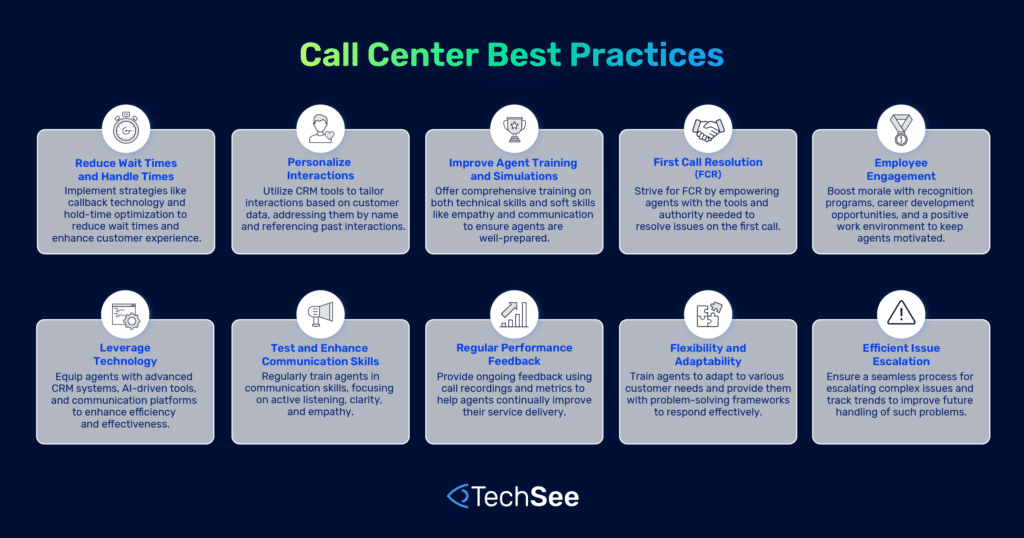Contents
Call centers are the frontline of customer service for many businesses. Providing excellent service in call centers is crucial for maintaining customer satisfaction and loyalty. However, call centers face a variety of challenges that can prevent them from delivering the best possible service. In this blog post, we will explore these pain points, discuss best practices, and describe how AI and automation can not only improve call center customer service – they can revolutionize it.
Pain Points in Call Center Customer Service
Phone Interactions
Call centers encounter a multitude of obstacles that hinder their ability to deliver high-quality service. One primary concern is long call wait and handle times. Customers often experience frustration when they are put on hold for extended periods. Studies have shown that customers are willing to wait a little longer than expected – but anything beyond that and they can become extremely dissatisfied.
Similarly, call center agents are measured on their average handle times. These two metrics are closely related, as longer handle times will naturally result in longer wait times for customers. This not only leads to dissatisfaction but also increases the likelihood that customers will abandon the call or, even worse, switch to a competitor or complain on social media.
Another significant pain point is the lack of personalization. Modern customers expect personalized, intuitive service. They want companies to remember their previous interactions and tailor their service to meet individual needs. A one-size-fits-all approach can make customers feel undervalued and overlooked.
Inadequate agent training is another critical challenge. Agents who are poorly trained may provide incorrect information or fail to understand the customer’s issue properly. This can result in multiple follow-up calls and longer average handle times, exacerbating customer frustration.
Moreover, high turnover rates in call centers lead to inexperienced staff and increased training costs, which further impact service quality. One common “magic bullet” fix is to deploy technology that can help less-experienced representatives. However, poorly implemented technology, a lack of integrations, and new technology training create additional issues, leading to service inefficiency. Similarly, outdated or inadequate technology can hamper an agent’s ability to assist customers effectively, leading to negative experiences.
Another common issue is a lack of communication skills among agents. When agents struggle to understand customers or clearly communicate instructions, there is a natural growth in misunderstandings and mismanagement of customer issues. Additionally, call center agents often struggle to maintain their upbeat attitude and professional motivation. Dealing with frustrated customers can take an emotional toll on agents.
Unmotivated staff can be detrimental to customer service experiences. Agents who lack enthusiasm or drive are less likely to go the extra mile to resolve customer issues effectively. To compound matters, complex customer issues that require a high level of expertise and patience often present challenges for first-line agents that lack familiarity and depth in the product or service in question.
Lastly, another prevalent customer frustration is with some Interactive Voice Response (IVR) systems. Some IVR systems can be difficult to navigate. Furthermore, when they fail to provide satisfactory resolutions, they can leave customers feeling even more frustrated.
Chat Interactions
Contact centers aren’t just for the phone. Chat interactions also present their own unique challenges. Here are the primary issues:
Agents typically handle multiple chat interactions at one time. This multitasking can lead to divided attention and slower response times, which might impact the customer experience negatively. While phone calls demand real-time engagement, chats allow agents to switch between multiple customers, which can result in inconsistencies and delays in response.
The format of chat interaction is another challenge. Chat is ideal for short back-and-forth messages, not lengthy discovery and troubleshooting sessions. The lack of visual aids, such as images or videos, further complicates complex problem-solving through chat. Unless a call center is leveraging visual intelligence, this limitation can make it difficult for customers to communicate their issues effectively and for agents to provide clear instructions, adding to customer frustration.
As with phone interactions and perhaps even moreso, the lack of personalization in chat bot interactions can be glaring. Customers expect bots to have access to their previous interactions and present tailored responses. A lack of AI in some chat bots prevents fully customized interactions to meet individual customer needs.
Poorly designed chat systems can be just as frustrating as bad phone IVR systems. If chat bots fail to understand the query or provide unhelpful responses, customers are left with a negative impression, feeling that their issues are not being adequately addressed. This can prompt them to seek more costly support channels like phone calls or even abandon the service altogether.
Addressing these specific challenges in both phone and chat interactions can go a long way toward improving call center customer service as doing so can better align service to modern customer expectations and improve overall satisfaction.
10 Call Center Best Practices

Today the technology exists to dramatically improve call center customer service, especially when making use of artificial intelligence. Even without using advanced AI systems, there are some basic changes you can make in your call center to align with best practices. We’ve listed the ten we find most valuable below. While some of these you may already know, it’s always good to reinforce what you are already doing right.
- Reduce Wait Times and Handle Times: Implementing strategies to manage call volume effectively is crucial. For example, turn hold time into gold time by collecting critical info and images of the issue while customers are on hold so agents can more quickly address their issues once they are available. Another approach is callback technology, which offers customers the option of receiving a callback instead of waiting on hold. This not only reduces wait times but also preserves the customer’s place in the queue, enhancing their overall experience.
- Personalize Interactions: Personalization should be a top priority. Utilize Customer Relationship Management (CRM) tools to gather and use customer data for personalized interactions. Agents should be trained to address customers by their names and reference their past interactions. Personalized service makes customers feel valued and understood, fostering loyalty and positive brand perception.
- Improve Agent Training and Simulations: Comprehensive training programs are essential for equipping agents with the necessary skills. Training should cover not only the technical aspects of the job but also soft skills like empathy and effective communication. Regular training sessions, simulations, and workshops can keep agents updated with the latest industry trends and best practices, ensuring they are well-prepared to handle any customer issue.
- First Call Resolution (FCR): Striving for first call resolution should be a key objective. This means resolving customer issues in the first call whenever possible, which significantly reduces customer effort and increases satisfaction. Providing agents with the right tools and authority to make decisions can help achieve this goal. Regularly analyzing call data to identify common issues and developing strategies to address them can also improve FCR rates. Companies across verticals are already implementing AI agents and assistants to streamline the resolution process to great effect.
- Employee Engagement: Keeping agents motivated is essential for maintaining high service standards. Recognition programs that highlight outstanding performance, career development opportunities, and fostering a positive work environment can significantly boost morale, as well as technology adoption. Highlighting employees who are strong adopters of the technology you implement and celebrating how their performance numbers improve will encourage others to adopt the technology. Engaged employees are more likely to be enthusiastic about their work and committed to providing excellent customer service.
- Leverage Technology: Equipping agents with the latest technology can greatly enhance their efficiency and effectiveness. Advanced CRM systems, AI-driven tools, and communication platforms enable agents to access customer information quickly, streamline processes, and provide accurate solutions. Some platforms make use of breakthrough AI Agent technology to proactively solve issues quickly and effectively, while reducing the strain on human agents. Regularly updating technology and providing ongoing training on new tools is crucial for maintaining high service standards.
- Test and Enhance Communication Skills: Effective communication is at the heart of excellent customer service. Offering regular training sessions focused on improving communication skills, including active listening, clarity, and empathy, can make a significant difference. Whether in-house or outsourced, it’s critical to ensure that agents representing your brand are adept at understanding customer needs, articulating solutions clearly, and handling difficult situations with empathy and professionalism.
- Regular Performance Feedback: Providing ongoing feedback to agents about their performance is essential for continuous improvement. Use call recordings and performance metrics to review service delivery and provide constructive feedback. Regular meetings and one-on-one sessions with supervisors can help agents understand their strengths and areas for improvement, fostering a culture of growth and development.
- Flexibility and Adaptability: Training agents to handle a wide range of issues and adapt quickly to different customer needs is crucial. Encourage agents to be flexible and think on their feet. Providing them with problem-solving frameworks and scenarios can help them respond effectively and improve service delivery. Set clear guidelines that empower agents to take initiative and make decisions independently – within reason; it’s important to safeguard against any accidental policy breaches.
- Efficient Issue Escalation: Having a clear and efficient process for escalating complex issues is vital. Agents should know when and how to escalate issues to more experienced staff or technical experts. Ensure that the escalation process is seamless and does not add unnecessary delays. This ensures that customers receive timely and accurate resolutions, even for complicated problems. Furthermore, tracking which issues are most likely to require escalation can help you proactively address these requirements in the future. This can include new training for tier-one agents, or updating the support flows to have agents utilize additional tools like TechSee earlier in the call when addressing more complex issues. Our customers report that when agents open TechSee earlier in their complex support calls, they can substantially reduce average handle times.
How to Improve Customer Service Skills in a Call Center
Improving customer service skills in a call center is a continuous process that involves strategic planning and commitment from management. Continuous training programs are fundamental in this regard. Regular training and simulation sessions should be organized to keep agents updated with the latest customer service techniques and tools. These training programs should encompass both technical skills and soft skills like empathy, patience, and effective communication.
Role-playing exercises are also highly beneficial for actually showing a team of agents how to improve customer service skills in a call center. These exercises allow agents to practice their skills in simulated real-life scenarios, preparing them for a variety of customer interactions. Through role-playing, agents can practice handling difficult conversations, managing irate customers, and resolving complex issues effectively. Additionally, mentoring and coaching programs can play a significant role in skill development. Pairing less experienced agents with senior agents allows for the sharing of valuable insights, guidance, and support.
Focus on Soft Skills
Soft skills development should be a focal point in any training program. Skills such as empathy, patience, and communication are critical for achieving high customer satisfaction. Ensuring that agents can relate to customers, understand their concerns, and communicate effectively can transform the customer experience. Moreover, providing agents with comprehensive resources is essential. Agents need access to all necessary information and tools to handle customer issues efficiently. This includes knowledge bases, FAQs, and up-to-date information on products and services.
Regular feedback loops are another crucial aspect of skill improvement. Constructive feedback from supervisors and customers should be shared with agents regularly to understand their strengths and identify areas for improvement. Clear performance metrics and goals must be set that are achievable and aligned with the overall objectives of the call center. Agents should also have total visibility into their real-time metrics as a means of improving and motivating performance.
A Supportive Environment
Fostering a positive work environment can significantly impact service quality. A supportive and encouraging workplace boosts morale and motivates agents to perform at their best. Empowering agents by giving them the authority to make certain decisions independently can also enhance service delivery. When agents feel trusted and valued, they are more likely to go the extra mile for customers.
Finally, encouraging lifelong learning is essential. Promoting a culture of continuous learning where agents are encouraged to take on new challenges and improve their skills constantly can lead to sustained improvements in customer service. Providing opportunities for professional development and advanced training can keep agents engaged and committed to their roles.
How to Improve Customer Service in a Call Center with AI
AI and automation are transforming the way call centers operate. Leveraging AI can significantly improve customer service by addressing common pain points and enhancing overall efficiency. One of the primary benefits of AI is its ability to reduce wait times through AI-driven call routing. AI can intelligently route calls to the most suitable agents based on various factors like skills, availability, and customer history. This ensures that customers are connected to the right agent quickly, reducing wait times and improving satisfaction.
Personalized customer interactions are another area where AI excels. AI can analyze customer data in real time to provide agents with relevant information, enabling more personalized and effective interactions. For example, AI can identify a customer’s purchase history, preferences, and past interactions, allowing agents to tailor their responses accordingly. This level of personalization makes customers feel valued and understood.
AI in Action
Advanced self-service options powered by AI can also enhance customer service. Implementing AI-powered chatbots, virtual assistants, or AI agents can handle routine queries, freeing up agents to handle more complex issues. These AI tools can provide instant responses to frequently asked questions, guide customers through troubleshooting steps, process simple transactions, and create post-service summaries. This improves efficiency and allows agents to focus on providing high-quality service for more intricate customer needs.
AI-powered analytics offer valuable insights into call center operations. AI tools can analyze call center interactions to identify trends and insights, helping managers make data-driven decisions to improve service. For example, AI can identify common customer complaints, peak call times, and agent performance metrics. This data can be used to refine processes, optimize staffing levels, and develop targeted training programs.
AI also enhances training and quality assurance. AI can monitor and analyze agent performance, offering real-time feedback and identifying areas for improvement. This continuous training and quality assurance lead to higher service standards. For instance, AI can detect patterns in agent behavior and provide personalized coaching recommendations to improve their performance.
Sophie AI takes that to another level. First, it learns what service flows, and solutions work best by monitoring service sessions and ingesting service documentation. Then, it autonomously trains customized AI models for service flows, which can help agents via Agent Assist, or autonomously help customers via the AI Agent. Similarly, Sophie AI observes the product visuals from TechSee Live sessions, autonomously training custom visual AI models that can automatically identify the make and model hardware, troubleshoot issues, and more.
Leveraging Visual Support
Visual support is another innovative application of AI in call centers. TechSee’s visual support technology allows customers to share images and videos with human agents or even with AI agents, enabling more accurate and quicker resolutions to issues. This is particularly useful for troubleshooting technical problems or providing step-by-step guidance. Visual support enhances the clarity of communication and reduces the time needed to resolve customer issues.
Call avoidance and containment are crucial for improving efficiency. AI can guide customers through visual flows to resolve issues without needing to speak to an agent. This improves efficiency and customer satisfaction by providing quick and accurate resolutions. Additionally, AI can customize the hold experience for customers and even leverage it for improved interactions. The “Hold Time is Gold Time” concept involves asking for valuable information during hold times, such as the customer name or ID, the specific product they need assistance with, and visuals of their issue. This expedites the time to resolution by giving an agent better understanding of the customer and their issue before the call even begins.
Moreover, AI and automation ensure 24/7/365 availability of customer service. Automated systems can provide support round-the-clock, ensuring customers receive assistance whenever they need it – even during peak season, crises and the holidays. This is particularly important for businesses with a global customer base, those that operate outside regular business hours and those with strongly seasonal peak volumes.
The Next Frontier of AI is Here
TechSee’s AI-driven solutions have made a significant impact on call centers globally. Companies looking to improve call center customer service have seen double digit reductions in average handling times, improvements in first call resolution rates, and increased customer satisfaction. For instance, Cochlear reported a reduction of 50% in complex call average handle time (AHT) after implementing TechSee’s visual assistance technology.
While there are many traditional methods to improve call center customer service, leveraging AI and automation represents the next frontier. These technologies not only address common pain points but also elevate service standards to new heights, ensuring customers receive the best possible experience. Embrace the future of customer service with AI, and unlock the full potential of your call center.
Ready to transform your call center? Discover how TechSee’s advanced AI technology can help you deliver exceptional customer service. Contact us today to schedule a demo and see the difference for yourself!








